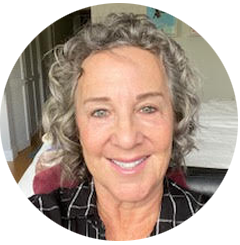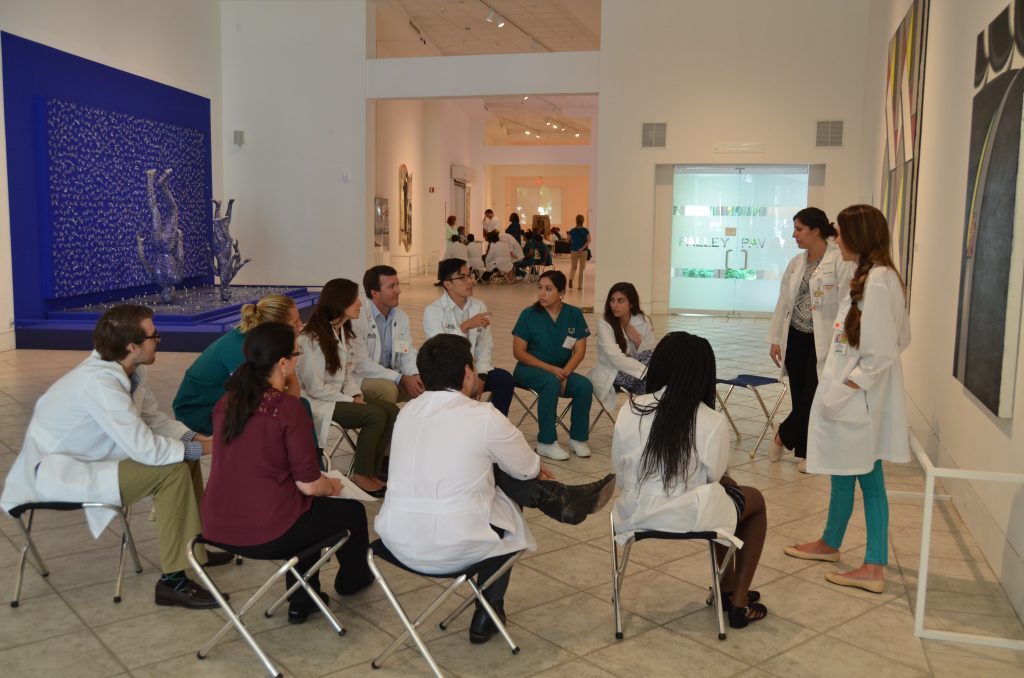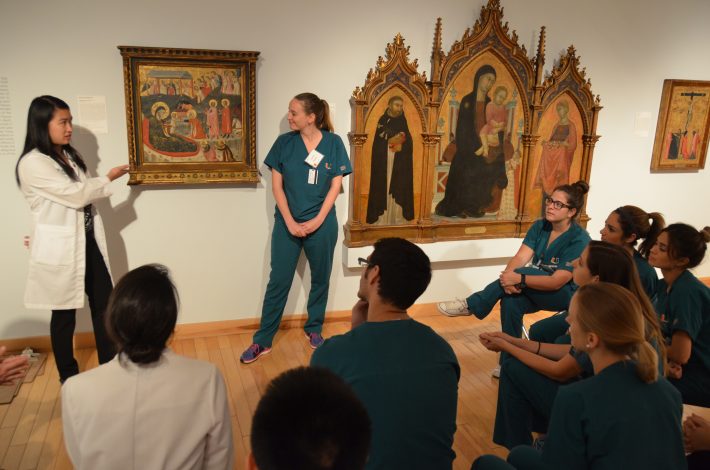A medical and a nursing student facilitating an image discussion.

Hope Torrents
School Programs Coordinator and Director of the Fine Art of Health Care program
Lowe Art Museum | University of Miami
Hope Torrents has been a museum educator for 21 years. Her interest in using art as a tool to hone clinical skills comes from her experience as a patient advocate and caretaker. She has attended and spoken at numerous conferences on healthcare and the humanities including, Harvard, Stanford, and the Mayo clinics in Jacksonville, Florida and Rochester, Minnesota.
Hope started the Fine Art of Health Care program at the Lowe Art Museum at the University of Miami in 2009. The inter-disciplinary program uses art to enhance observation and communication skills in the service of clinical diagnosis. The interprofessional workshops have evolved with the partnerships of doctors, nurses, and DNP faculty from the Miller School of Medicine and the School of Nursing Health studies. Other partnerships include the Lennar Medical Center and Sylvester Cancer Center.

“I wish your husband came to me 5 years earlier.” That’s what the Whipple surgeon said to me after my husband was diagnosed with pancreatic cancer. From 2010-2016 my husband was in and out of the hospital 40-50 times. And after 5 surgeries and a trip to Mayo Clinic for recurring blood infections I was steeped in navigating someone else’s health care. I wouldn’t wish my experience on anyone but in spite of the challenges, it furthered my interest and commitment to collaborate in developing an inter-professional program that uses art to hone clinical skills. Working at the Lowe Art Museum, University of Miami, for over 20 years helped me fine-tune my own skills in observation, communication, critical thinking, navigating ambiguity and cultural humility–Important skills for anyone and equally valuable for those who are working in health care.
The Fine Art of Health Care program was created and developed in 2009 by a team of Deans, professors, and museum educators to bring together graduate students in medicine, nursing, physical therapy, and psychology in the museum to make meaning while looking at and discussing works of art in the Lowe Art Museum’s permanent collection. The museum is a space in which students are asked to slow-down, step-back, and look at works of art for a sustained period (close looking), taking into consideration different perspectives about art. We ask the students to not only participate in these discussions, we ask that they facilitate, so they are put into the position of having to put their own thoughts/opinions/implicit biases away and take in the perspectives of the group. Participants agree, disagree, and build upon one another’s ideas. Art provides a perfect platform for group discussions because there isn’t one correct answer. Art is static. A patient is not. A patient’s illness evolves, change happens over time. It’s imperative that health care providers adapt and communicate effectively the changes that occur in a patient over the course of their illness. This includes using skills such as close looking, active listening and effective communication.
Errors occurring during routine healthcare encounters are currently the third leading cause of death in the US, contributing to approximately 440,000 preventable deaths annually. Communication and teamwork failures have been found to be among the most common contributing factors in virtually all healthcare errors. Recent literature illuminates the role implicit bias may play in communication failures and inadequate team collaboration. Race, gender, social status and age biases can be problematic during healthcare professionals’ interactions with each other as well as with their patients. Recently, art-based education for physician residents has been successfully used to address cognitive biases by improving participants’ understanding and, empowering participants to address their biases by deepening their appreciation of how quickly they jump to conclusions and by helping them to acknowledge the difficulty of separating observation from interpretation. Given the association among preconceptions, teamwork and communication failures, patient safety, and health disparities, a number of organizations have called for increasing training and opportunities in Inter-Professional Education which may assist in improving the quality and safety of healthcare.
My husband was from Spain. Health care in any country is complicated and speaking a different language and having different values made navigating the American system that much more difficult. He had no idea in what direction to go. And I had never been a patient’s advocate. I was tasked with finding the right physicians, surgeons, after-care, sending slides to pathologists around the country, arranging for trips to other clinics. Relaying all this information to someone whose first language wasn’t English was daunting and difficult for a neophyte like me. I had been there when my father died of sepsis, a sad and too-fast ending, but taking care of someone as sick as my husband over a 6-7year period was another story. Managing a job, 3 children, and a home was overwhelming. Propelling my anxiety and frustration into a program that focused on skills that were imperative to my husband’s well-being was fortuitous. The learning curve was steep for me and the team I put together to make the Fine Art of Health Care a success. We read. We watched videos. We tried new activities. I also presented at conferences in this country and Europe and learned what was happening in the way of integrating new modalities into health care education. As a team we have worked over the 11 years to build-out and improve the program. A lot of trial and many errors.
The Fine Art of Health Care program uses Visual Thinking Strategies (VTS), a methodology that has been used in elementary schools, art museums, police academies, and most recently in health professions schools. VTS involves the use of facilitated group discussions; each participant has the opportunity to express opinions about a piece of art using three questions: 1. What is going on in this image? 2. What do you see that makes you say that? 3. What more can you find? Facilitators paraphrase participants’ responses and point to the details under discussion.
The Miller School of Medicine has participated in the program for ten years, first on a voluntary basis for medical students and now as a required session in Visual Thinking Strategies for first year medical students. Dr. Gauri Agarawal, the Associate Regional Dean for Medical Curriculum and Associate Professor of Medicine at the University of Miami, said that the school received positive feedback from the students, “They understand it can provide insight into the human condition and suffering, emphasize perspective, and develop and nurture observation and analytic skills, empathy, and self-reflection.”
The School of Nursing and the Department of Physical Therapy are also active participants in the program. According to Jill Sanko, PhD, APRN, CHSE-A, FSSH, “together we have been able to offer unique learning opportunities using the backdrop of beautiful works of art through the Lowe’s Fine Art of Healthcare program. Such training can allow participants to recognize the power of “slow looking,” or turning one’s full visual attention to the details in a work of art. These skills can subsequently be used in clinical contexts when healthcare professionals turn their full visual attention to a patient’s body during a physical examination, while interpreting radiographic or pathologic images, or taking note of exposed anatomic structures within a surgical field. This is particularly applicable to healthcare professionals who work with increasingly diverse groups of patients and colleagues, each with their own history, heritage, and mindset.”
The Department of Physical Therapy has participated in Fine Art of Health Care workshops for more than ten years. Dr. Neva Kirk-Sanchez, Chair of the Department, is interested in analyzing the impact of the workshops on interprofessional views and behaviors related to communication, team interactions and IP implicit bias. She believes that educating students on ways to improve collaboration and communication and diminish cognitive biases may have far-reaching impacts in decreasing healthcare errors and improving healthcare quality.
In 2016 my husband died. Much of our work in creating the Fine Art of Health Care program was built on the experiences I had as a patient advocate. The Fine Art of Health Care inter-professional program is in its 11th year. New cohorts continue to participate. These include: residents in psychiatry, pediatrics, psychiatry, radiology, staff from the Sylvester Cancer Center, practicing physicians, nurses, social workers, psychologists. The central tenant is effective communication. Effective communication can save lives.
References and Further Reading
1. Perry M, et al The effectiveness of arts-based interventions in medical education: a literature review. Med Educ. 2011 Feb;45(2):141-8.
2. Reilly JM, Ring J, Duke L. Visual thinking strategies: a new role for art in medical education. Fam Med. 2005 Apr;37(4):250-2.
3. Bardes C, Gillers D, Herman A. (2001). Learning to look: developing clinical observational skills at an art museum. Med Educ. 2001;35:1157-1161.
4. Dolev JC, Friedlaender LK, Braverman I. Use of fine art to enhance visual diagnostic skills. JAMA. 2001;286:1020.
5. Frei J, Alvarez SE, Alexander MB. Ways of seeing: Using the visual arts in nursing education. Journal of Nursing Education and Practice (2010); 49(12): 672-676.
6. Heyn R, Familiari G. Visual thinking strategy in the medical curriculum: training the “clinical eye” in classrooms and art museums. Journal of Anatomy Embryology. 2015; 120(supp 1):235.
7. Agarwal G, McNulty M, Santiago KM, et al. Impact of Visual Thinking Strategies (VTS) on the Analysis of Clinical Images: A Pre-Post Study of VTS in First-Year Medical Students. Journal of Medical Humanities;2020. doi.org/10.1007/s10912-020-09652-4
8. Mckary D. Medical error, the third leading cause of death in the US. BMJ, 2016;353: i2139.
9. James JT. A new evidence-based estimate of patient harms associated with hospital care. Journal of Patient Safety 2013;9(3):122-128.
10. Braun, Hillary J, O’Sullivan, Patricia S, Dusch, Marie N, Antrum, Sheila, & Ascher, Nancy L. Improving interprofessional collaboration: Evaluation of implicit attitudes in the surgeon–nurse relationship. International Journal of Surgery. 2014;13:175-179.
11. Zeidan, A., Tiballi, A., Woodward, M. & Di Bartolo, I.M. (2020). Targeting implicit bias in medicine: lessons from art and archaeology. West Journal of Emergency Medicine, 21(1), 1-3.
13. Ruben M, Saks NS. Addressing implicit bias in first-year medical students: a longitudinal, multidisciplinary training program. Medical Science Education (2020). https://link.springer.com/article/10.1007/s40670-020-01047-3
Photo Credits
Photo 1:
(L) The Adoration of the Magi, Artist/Maker: Master of the Blessed Clare of Rimini (Italy, active ca. 1340-1345), Date: ca. 1340, Medium: tempera on wood, Credit Line: Gift of The Samuel H. Kress Foundation.
(R) Madonna and Child Enthroned with Donors and Saints Dominic and Elizabeth of Hungary, Artist/Maker: Lippo Vanni (Italy, active 1344-1376), Date: ca. 1343, Medium: tempera on wood
Credit Line: Gift of The Samuel H. Kress Foundation
Photo 2:
(background) Breathing Glass, Artist/Maker: Sandy Skoglund (United States, b. 1946)
Date:2000, Medium: individually lampworked glass dragonflies, mini-marshmallows, molded plastic figures and glass mosaic, Credit Line: Gift of an Anonymous Donor








